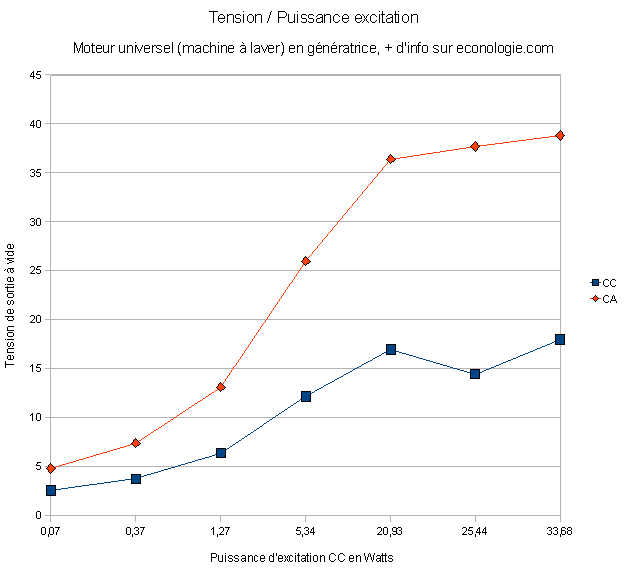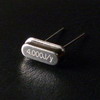As part of my paddlewheel "project": https://www.econologie.com/forums/tambour-de ... t6303.html i need to find a generator. I think this is the case for a lot of people with a renewable energy project and I didn't want to go into the "commercial" logic of big investments.
Apparently luck smiles for me because I have recovered (with the 2 recovery drums) 2 washing machine motors, here is one of the 2:
These 2 motors are called "universal motor" with carbon (being able to work in CC and AC) which are (thank you chatelot) reversible without any modification. The purpose of the subject is to find the limits and optimum operating point in generator mode.
So I asked a few questions and had very interesting answers on this subject: https://www.econologie.com/forums/cablage-mo ... t6816.html which quickly became out of topic from which the creation of this new subject.
Here is a small summary of what has already been done or said.
The basics you need to know about universal engines in generator mode
chatelot16 wrote:there is not a universal transform engine is also a dynamo
the stator winding is excitation, DC comes from coal
but watch the current of excitation is roughly the same as the current product: it is not a disaster because the excitation voltage is much lower than the output voltage: a converter decoupage is essential to the excitation without loss
pifometrique example (it will make a precise measurement)
current product 200V 2A
excitation 5V 2A
but it is driving the motor rated speed: when the speed decreases the power output and lower power excitation remains constant
original method: make a generator of sinusoidal excitation electronics 50 Hz and recovered by coal power 50 Hz although the speed is variable
I've never seen use this principle but it has to serve pourais 50Hz an alternator with a turbine that spins very quickly
Christophe wrote:And here are the curves 2, how did I do it?
a) Adjustable DC excitation (9 measurement points from 0.48V to 10.30 V). Made by a laboratory 12V 3A stabilized power supply ... I do not exceed the 10.30 because the amperage reaches its maximum for the power supply!
b) Excitation on the stator, output on the rotor as indicated by Chatelot (the reverse can not be too?)
c) I activate the rotor with a small screwdriver (fully). Hoping that the speed of rotation is constant ...
d) I made a DC and AC measurement with an ultrabasic voltmeter. How much difference do you think? We must be far from the sine of 50Hz AC side ... surely for that ... Tomorrow I put the oscillo on it that I received for Christmas !!
Results:
a) Output voltage / excitation voltage
b) Output voltage / excitation power
Is there a "shady" point at 9.02 Volts in DC? I have trouble reading?
What do the experts think about electric motors / generators? In any case, a big thank you lv13r and Chatelot in absentia (if it says in this context)
Well we're off topic finally ... Here I am excited!
And chatelot (always and again) that confirms my doubt about AC measurements:
chatelot16 wrote:I just read a little better: you still exite in cc: the output is always in cc
and you have fallen into the trap of the little multimeter who only measures an alternace on 2 by multiplying by 2 to make good average with the other alternation which is not measured: if you put your voltmetre AC in the other meaning you will always have 0
to have the alternative it is really necessary to exite in alternative, for example with a transformer 220v has secondary 5v or 12v ...
And here are the last exchanges https://www.econologie.com/forums/post110631.html#110631
chatelot16 wrote:to read your curves well it would be necessary to put the tension of exitation on a linear scale: you will see that beyond a certain exitation the tension of exit does not increase in proportion: it is sign that the magnetic circuit saturates , so that the yield becomes bad
Good point is what it seemed to me (there was a maximum / optimum) because 30W excitation (for a given engine for 225W) seems really huge!
chatelot16 wrote:at random without tracing the curve I would say not to exceed 5v
Ok I guess there is an optimum to be determined case by case (depending on the RPM and type of windings)
Question: Does the load count? That is to say ideally should a variable excitation depending on the load?
chatelot16 wrote:to increase the tension it is necessary to increase the speed
it is not a type of engine adapted to low speed
Ben I'm still surprised by the results because a screwdriver turns quite weakly (I have more doc but I do not think it exceeds the 400-500 rpm) it is not a drill!
Ah my humble opinion it will suffice for what I want to do.
Today I will try to excite with 12V AC to see if it's better? And I will connect the oscilloscope!
ps: for those who want to change a generator asynchronous motor go on this topic: https://www.econologie.com/forums/moteur-asy ... t6820.html
Apparently it is enough to add a capacitor in // of the power supply (in single-phase, in three-phase it is necessary to pass in star if possible and to add 3 capacitors).






